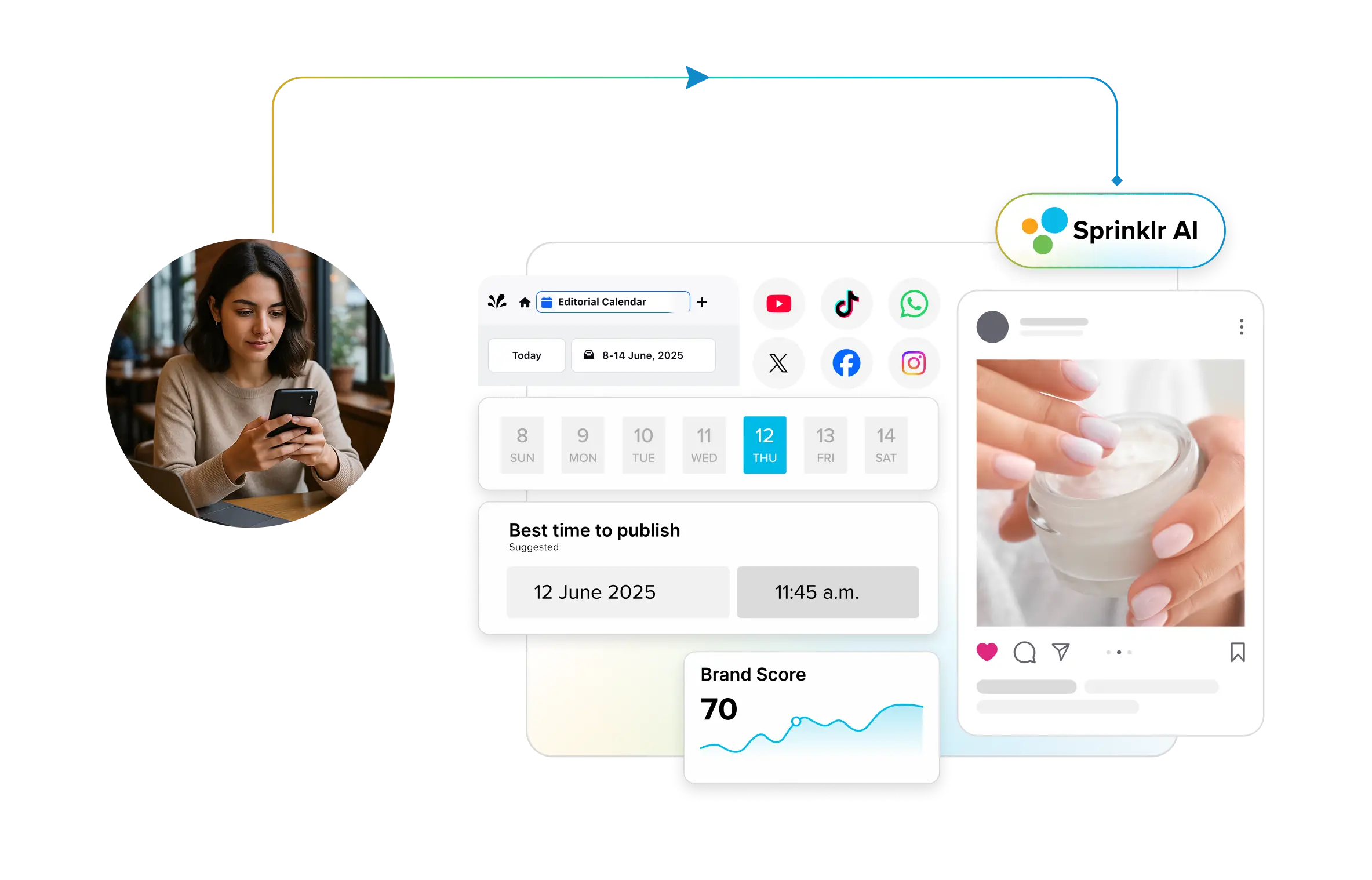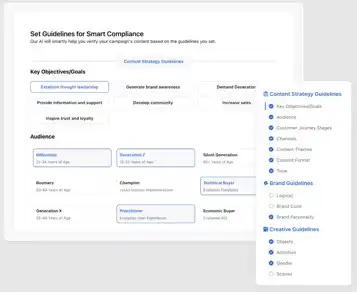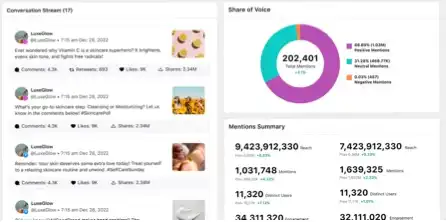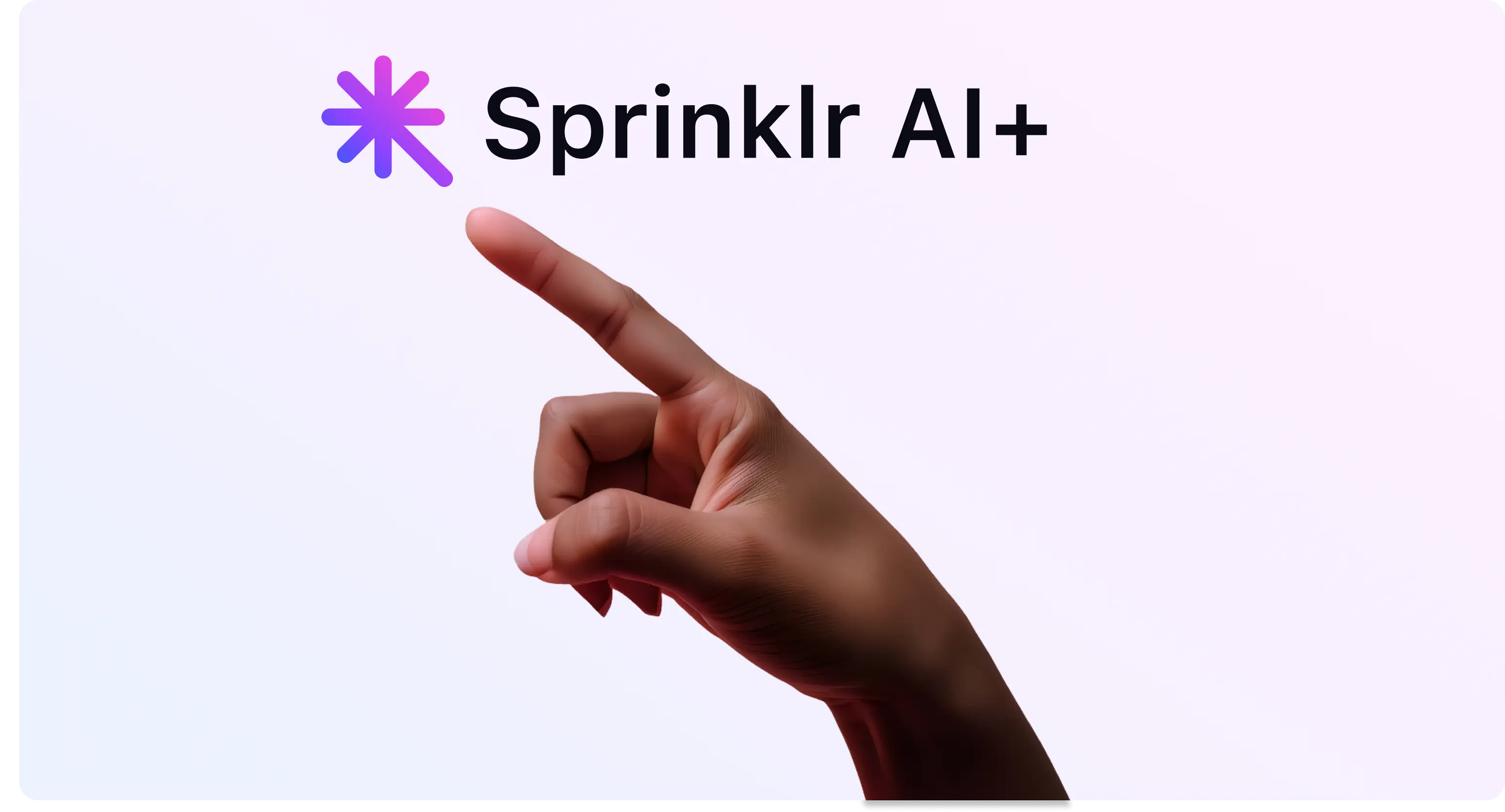The global leader in enterprise social media management
For over a decade, Sprinklr Social has helped the world’s biggest brands reimagine social media as a growth driver with a unified platform, industry-leading AI and enterprise-grade scale.

Role of GDPR in Social Media Marketing [+ Things to avoid]
With great power comes great responsibility.
We’re not just using the popular Spiderman adage as a punchline. That’s what the bridge between GDPR and social media demands from today’s marketers and brands.
Flouting GDPR norms is a costly affair. The average fine per GDPR violation in 2023 was €4.4 million, which is a steep rise from €500,000 in 2019. The message is clear: companies that mishandle customers’ personal data and undermine their privacy will have to pay dearly.
If you think that GDPR doesn’t extend to social media, hear us out! You’ll be surprised to know that GDPR is not only limited to how companies collect and control the EU region’s user data on their websites, but even how they use that data on social media.
And now with generative AI entering the social media AI tools fray, there is additional scrutiny on how companies use customer data. That puts AI firmly in the purview of GDPR. Generative AI’s inroads into content and social media poses risks on how platforms may collect user and behavioral data for machine learning and accessibility of those data over “prompts.”
Your brand’s social media activities and their adherence to the privacy laws that GDPR governs are always under the radar. Let’s break down everything you need to know as a social media marketer to abide by GDPR and meet high brand safety standards.
What is GDPR?
The General Data Protection Regulation (GDPR) is a law implemented by the European Union (EU) to safeguard the personal data of consumers from their region.
It provides EU consumers more control over how their data is collected and processed by businesses. Simply put, if you’re an EU resident, you need to provide your consent for businesses to access or use your personal data for any purpose. A few examples of personal data that GDPR safeguards:
- Names and email
- Date of birth
- Browser cookies, tracking pixels and IP address
- Race, ethnicity and religion
- Demographics such as region, education, address and occupation
- Genetic, biometric and health data
And pretty much any data that makes you identifiable. So what does that look like in terms of your browsing experience? You will no more be a part of over-the-top personalized user journeys. Every digital footprint you leave is not shared across sites to build journeys and retargeting campaigns without your explicit consent.
To get an idea how this plays out practically, take a look at the below opt-in designed to procure user permission for LinkedIn retargeting:
GDPR mandates businesses to ask for user consent and give users complete context about how they are using the data.
You know who to thank the next time you opt-out of a newsletter you no longer consume; delete all your engagement data stored by a social media app; deny cross-site cookie tracking in website pop-ups.
What are the countries bound by GDPR?
Here’s a list of countries that are a part of the EU, protected by the GDPR law since May 2019.
Austria | Germany | Poland |
Belgium | Greece | Portugal |
Bulgaria | Hungary | Romania |
Croatia | Ireland | Slovakia |
Cyprus | Italy | Slovenia |
Czech Republic | Latvia | Spain |
Denmark | Lithuania | Sweden |
Estonia | Luxembourg | United Kingdom |
Finland | Malta |
|
France | The Netherlands |
|
The GDPR also applies to non-EU nations such as Iceland, Liechtenstein and Norway as they are a part of the European Economic Area.
While the United Kingdom is not a part of the EU now, GDPR still stands as it was implemented when they were a part of it. Switzerland has its own but similar version of GDPR, called the Federal Act on Data Protection (FADP).
And businesses outside the EU aren't off the hook from GDPR. As long as any business is involved in collecting and processing the personal data of EU users, they are required to adhere to it.
How does GDPR impact social media marketing?
Since GDPR’s onset in May 2018, GDPR has had a huge bearing on how social media apps process user data for marketing purposes. From organic marketing to social advertising, most aspects of social media marketing are impacted by GDPR.
1. Customizing user experiences around consent
Gone are the days of sneakily collecting data. Now, you need explicit consent from users before you can process their personal information. This means those pre-checked opt-in boxes and vague privacy policies are a big no-no.
How to stay GDPR compliant: Make your consent requests concise, specific, and easy to understand. Think of it as a first date – be upfront about your intentions so that both the parties know what they are getting into. For instance, Meta’s disclaimer about sharing user activity across their partner ad networks is transparent and easy to understand.
2. Limit your user data collection to the basics
GDPR encourages collecting only the data that companies absolutely need. Imagine you're running a simple sign-up or lead gen ad on socials. The landing page form asks for:
- Name
- Date of birth
- LinkedIn profile
- Last Netflix series you watched (okay, not this but you get the idea)
Unless you're running an age-restricted service or sending birthday promotions, do you really need to know when your subscribers were born? That's a classic case of unwanted data right there. And a LinkedIn profile field is still sensitive information that makes the user even more vulnerable.
How to stay GDPR compliant: A GDPR-friendly alternative would be sticking to just name and email fields. If you must verify age, consider a simple "Are you over 18?" checkbox instead. Take a good, hard look at all the data you're collecting. Ask yourself, "Do we really need this info?" If the answer isn't a resounding YES, it's time to let it go.
3. Erasing users’ digital traces, no questions asked
Users now have the right to request that their data be erased. This can be tricky for social media marketers who rely on historical data for targeting and analytics.
But in a way, these ethical practices are a win-win for both social media marketers and users. While users get back the elusive control over their data, marketers end up finding more creative ways to woo their in-market users with memorable value props, storytelling and branding activities.
How to stay GDPR compliant: Do a periodic data cleanup to phase out user data that your marketing or sales teams no longer need. Consider setting up automations that delete user data when they are no longer engaging with your brand.
4. Publicly accessible social media data of users aren’t up for reuse by default
If someone has followed your business on socials, it doesn’t give you the default right to access their personal information.
Especially with user-generated content performing well for brands, there’s a lot of room for social media marketers to falsely assume consent. You still need to set up guidelines to reuse content posted by individuals about your brand.
How to stay GDPR compliant: You need explicit permission from users before you can use their content, and you've got to ensure you're not inadvertently revealing any personal information. A workaround for this would be to leverage social media collaboration that apps like Instagram support for reposts, branded content and paid partnerships.
You'll receive a notification in your Instagram inbox as a pop-up or an in-feed alert.
Otherwise, you need to take this up with the user whose content has a positive featurette of your business or product before you freely reuse it for social media marketing.
💡 Pro Tip: If you’re managing a social media team, monitor every activity of your marketers for brand and GDPR compliance. Right from privacy to tone to brand values, everything matters if you’re looking to be consistent on social media.
Tools like Sprinklr Compliance can help you be more diligent about brand safety while removing the grunt work of manual governance.
You can set up automated governance workflows with AI-powered compliance reporting and safety benchmarks.

Examples of brands leading the way in adapting to GDPR
Let's look at how some big players have adapted their social media strategies in wake of GDPR:
Any new digital law comes with a lot of tedious legalese. And Facebook didn’t have it easy when GDPR was implemented. But after facing initial scrutiny for its data practices, Facebook went on a privacy renovation spree.
They introduced clearer privacy settings, gave users more control over their data, and even launched a "Clear History" option for activity logs, integrations and other avenues which collect personal data.
Airbnb
Airbnb nailed the consent game by creating a user-friendly privacy preferences center. Users can easily manage their data sharing preferences, including opting out of personalized ads.
A lot of businesses use “dark patterns” in UI design to hide privacy settings from simple access. Airbnb was one of the firsts to break this sneaky GDPR practice by making the privacy settings readily accessible.
Microsoft
Microsoft has actively ensured GDPR compliance across all its platforms, including social media. They have made their privacy policies more transparent regarding data collection and usage. Microsoft offers users tools to manage their data, such as viewing, exporting, and deleting personal information. They also ensure that any data collected through social media channels is done with explicit user consent, maintaining high standards of data protection and privacy.
💡 Pro Tip: To make your brand compliance on social media more proactive, you can use social listening dashboards to keep tabs on conversations about data breaches, negative sentiment, and mentions from customers requesting GDPR-related actions.
For instance, Sprinklr Social Listening fetches real-time social conversations around your brand and custom topics in a unified dashboard. You can jump on any engagement that toes the line of brand safety and compliance.

How to ensure your social media marketing is GDPR-compliant and avoid common pitfalls
To sum up, here are some top-of-mind pointers to help you stay on the right side of GDPR as a social media marketer:
Conduct timely and frequent data audit
The first step in GDPR compliance is understanding your existing data practices. Begin by thoroughly examining what personal data you're collecting, why you're collecting it, where it's stored, and how it's processed. This audit should cover all aspects of your social media marketing, from lead generation forms to audience targeting tools.
Don’t assume consent
Make your data collection and usage practices crystal clear to users and obtain their explicit permission before processing any personal information. Even user-generated content around your business doesn’t entitle you to reuse it without their consent.
Avoid over-dependence on audience targeting
Instead of doubling down on deanonymization tactics, explore contextual advertising and social selling. Explore demand generation and brand building to create a buying trigger instead of relying on contact information. Your prospects will signal intent when they are ready. But try to give them a free hand at charting their own customer journey.
Limit data access within your org
Implement strict access controls to ensure that only authorized personnel can access user data. This isn't just about preventing external breaches; it's also about internal data governance. Create clear roles and responsibilities for data handling within your team. Someone managing your social media content doesn't necessarily need access to user email addresses or other personal information.
User rights in GDPR shouldn’t be an afterthought
Develop streamlined processes for handling data access, erasure and correction requests from users. Ensure that every GDPR-related request from a user is fast-tracked through instant automations.
Don’t underestimate the significance of employee training
Your brand is accountable for every password mishap, platform access and roles and permissions given to your marketers. This could include workshops on data handling best practices, updates on GDPR interpretations, and practical scenarios relevant to your social media marketing activities. Consider building interactive training programs with guided cues about GDPR and compliance awareness.
Implement proactive data protection mechanisms
This includes technical measures like encryption, secure networks, and strong authentication processes. Remember, this is apart from your usual security audits and incident response plans.
Don’t hide your privacy policy behind fine print
Be transparent about your data practices and give users easy-to-understand information about how their information is being used. Your privacy policy needs to be clear, comprehensive, and accessible. It should detail what data you collect, why you collect it, how you use it, who you share it with, and how long you retain it.
Regularly update your compliance
GDPR compliance is an ongoing process, not a one-time task. Regularly review and update your compliance measures to ensure they remain effective and aligned with any new guidance or interpretations of the regulation. Set up a schedule for periodic reviews of your data practices. This could involve quarterly audits of your data collection points, annual reviews of your privacy policies, or monthly checks of your data storage systems.
Don’t hoard user data beyond a reasonable timeline
Keep user data only for as long as necessary for the purpose it was collected. One way to ensure this is to automatically remove contact data out of tools like CRM and marketing automation, if they have not engaged over a period of time.
When you leverage GDPR as an opportunity to build trust with your audience, you can turn compliance into a competitive advantage. After all, we’re already seeing brands like Apple pivot their primary messaging around the privacy that their devices offer.
Partner with Sprinklr for GDPR-compliant social media marketing
Social media marketing is as much a safety game as it is a consistency game. By embracing GDPR principles, you're not just ticking compliance boxes; you're showing your audience that you respect their privacy.
But of course, factors like cookie and pixel tracking deprecation does weigh in heavily on social media marketers. It’s a delicate balance that you need to tread, especially when you’re managing socials and ads across multiple channels.
If you’re looking for an end-to-end social media management platform that’s purpose-built around privacy and compliance guidelines, Sprinklr Social might be just what your brand needs. With Sprinklr, you can:
- Create GDPR-friendly custom lookalike audiences across Facebook, X (formerly Twitter), TikTok, LinkedIn, Instagram, Snapchat and more from a unified platform.
- Manage and automate social media roles, access, permissions, publishing frameworks and approvals with AI-powered 360-degree compliance.
- Actively monitor sentiment and compliance by surfacing ongoing conversations about your brand or just about any topic in real-time with social listening dashboards.
- Build automated workflows to process GDPR requests from users in no time.
Plan, organize, publish and manage your socials with AI-powered risk mitigation. Explore Sprinklr with a full-featured 30-day free trial and give your social media channels the compliance aircover they need.









